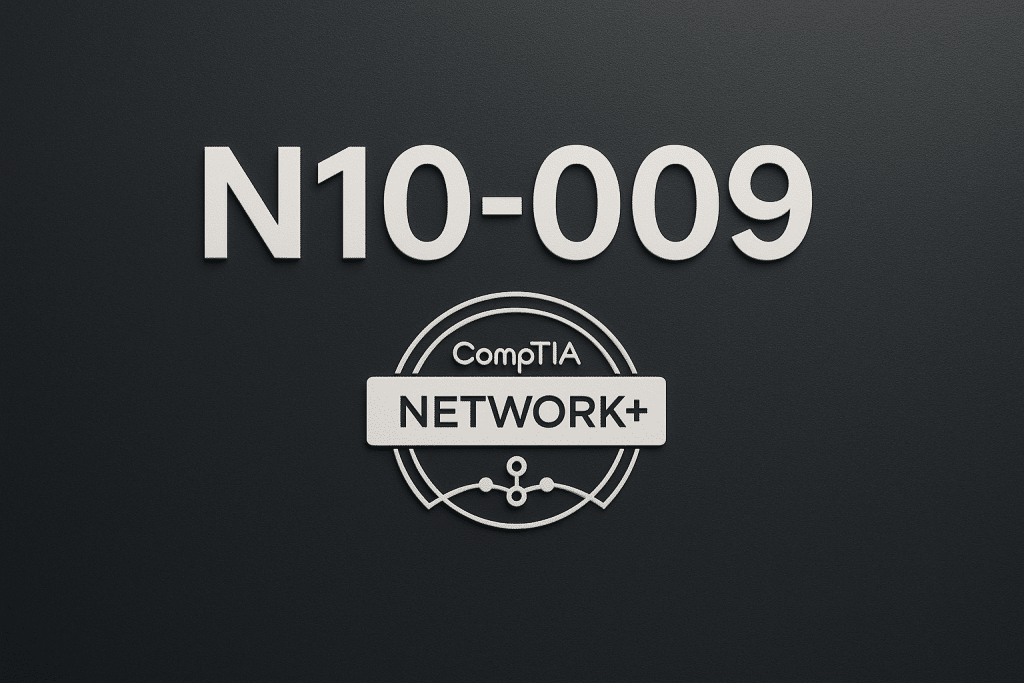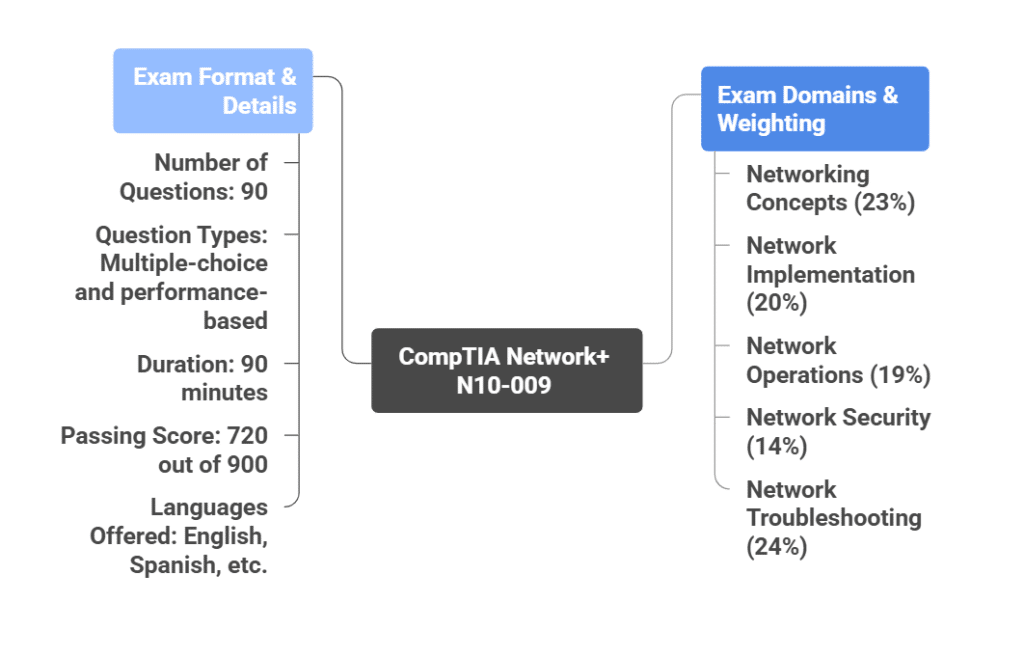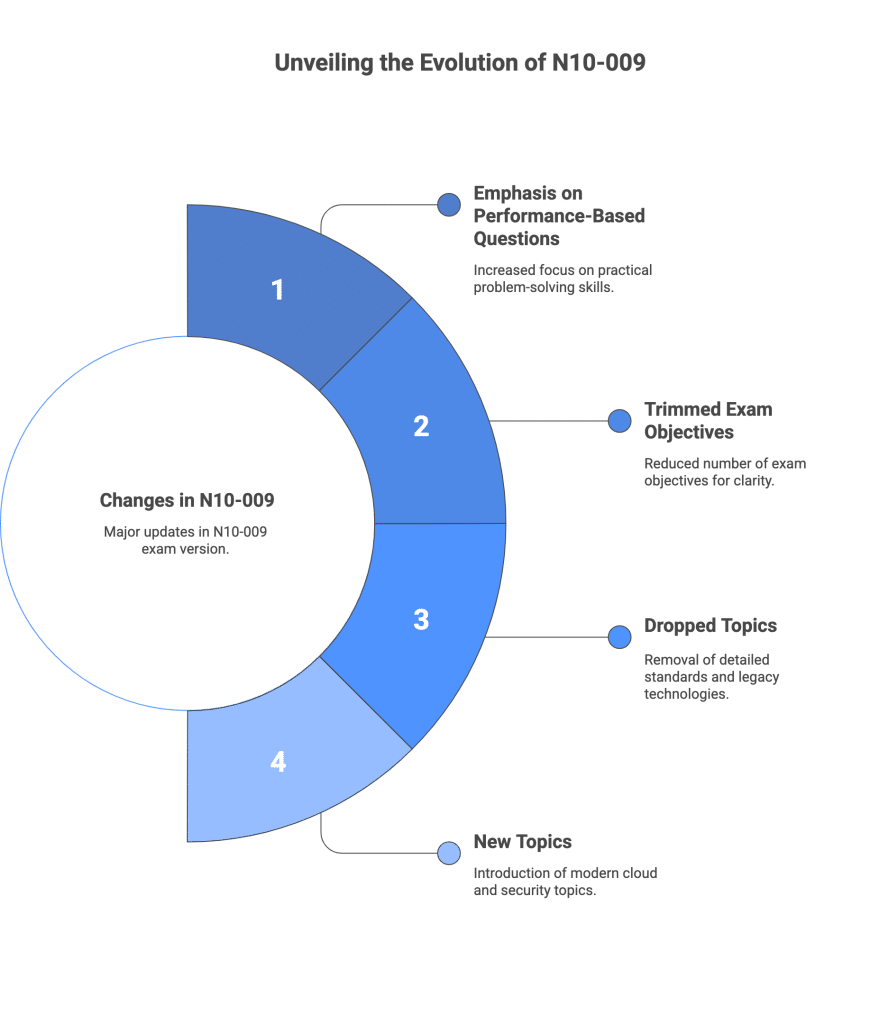
What is N10-009?
CompTIA Network+ (N10-009) is the latest version of CompTIA’s globally recognized networking certification, released in June 2024 to replace N10-008. It is a vendor-neutral exam that validates essential knowledge and skills in networking, including fundamentals, implementation, operations, security, and troubleshooting of wired and wireless networks. Unlike vendor-specific certifications, N10-009 covers a broad range of modern networking technologies such as cloud networking, virtualization, software-defined networking (SDN), and zero-trust security models.
Designed for entry- to mid-level IT professionals, it serves as a strong foundation for roles like network support specialist, junior network administrator, and NOC technician, making it one of the most important certifications for anyone starting or advancing a career in networking.
Who should take this exam?
CompTIA Network+ (N10-009) certification is suitable for:
- Those who already hold CompTIA A+ and have some hands-on experience (around 9-12 months) typically do better.
- Entry-level to intermediate IT professionals who want to work in network administration or support roles.
- Network technicians, support specialists, junior network administrators.
- Also good for people moving from help desk / general IT roles who want to specialize in networking.
Prerequisites and recommendations
- There are no formal prerequisites for taking Network+ (N10-009). CompTIA does recommend having CompTIA A+ and/or around 9-12 months of hands-on networking experience.
- Also recommended: familiarity with basic concepts like IP addressing, basic router/switch operations, wireless setup, etc. Having studied for A+ or done help desk work helps.
- Recommended study materials: up-to-date books, video courses matching N10-009, hands-on labs or simulations. Practice tests, quizzes.
Exam objectives and domains
- Networking Fundamentals (23%)
- Network Implementations (20%)
- Network Operations (19%)
- Network Security (14%)
- Network Troubleshooting (24%)
- I prefer this response
Objective details by domain

1. Networking Fundamentals
You should be able to:
- Explain the layers of OSI & TCP-IP, and how they map to real-world protocols.
- Understand and design IP addressing: IPv4 and IPv6, subnetting, CIDR notation, recognizing issues like address exhaustion.
- Virtualization and cloud networking: Virtual Private Cloud (VPC), gateway services, cloud network security groups.
- Software defined networking (SDN), software defined WAN (SD-WAN), Infrastructure as Code (IaC).
- Recognize network topologies, physical vs logical connections.
2. Network Implementations
You should be able to:
- Design and install wired and wireless networks: cables, connectors; switch & router setup; access point placement; wireless channel/band planning.
- Implement VLANs (including SVIs), link aggregation, trunking.
- Physical installations: racking, cooling, power, airflow, cable management.
- Deliver network services: DHCP, DNS (including newer secure DNS protocols), port assignment.
- Understand wireless standards, bandwidth, interference.
3. Network Operations
You should be able to:
- Monitor network: using SNMP, flow data, APIs, log aggregation; measure performance metrics.
- Understand and apply lifecycle, change, configuration management.
- Documentation: network diagrams, rack diagrams, asset registers.
- Manage incidents, disasters: RTO/RPO, cold vs warm vs hot sites; backup & restore.
- Cloud and virtual network operations: how virtual networks behave, overlay, underlay.
4. Network Security
You should be able to:
- Explain threat types and attack vectors: DoS, VLAN hopping, MAC flooding, ARP spoofing, DNS poisoning etc.
- Understand security controls: firewalls, ACLs, NAC, encryption, zero trust, multi-factor authentication, IAM, SSO.
- Compliance requirements: GDPR, PCI DSS etc.
- Physical security as well, securing equipment, access to hardware.
5. Network Troubleshooting
You should be able to:
- Service issues: DNS resolution, DHCP lease problems etc.
- Use a step-by-step methodology to isolate and fix network issues.
- Troubleshoot errors at physical layer: cable problems, bad connectors, duplex/speed mismatches.
- Identify switching/routing issues: mis-configured VLANs, missing routes, default gateway problems.
- Wireless troubleshooting: interference, signal strength, roaming issues.
What changed in this version?
Here are the major changes introduced with N10-009. Useful if you’re migrating your study from N10-008 or comparing both.
- More emphasis on performance-based questions and problem solving instead of pure memorization.
- The exam objectives were trimmed: the number of topics has decreased (from ~590 objectives in N10-008 to ~430 in N10-009).
- Some topics were dropped: very detailed standards (many IEEE wireless specs), certain physical tools, some legacy technologies. Also some rote memorization topics have been removed.
- New topics added or expanded: modern cloud networking; SDN / SD-WAN; infrastructure as code; zero-trust architectures; VxLAN; more about physical installation best practices; updated secure DNS and time protocols like PTP/NTS.

Registration and scheduling
- You register via CompTIA’s website or through authorized test centers/partners. Typically through Pearson VUE or similar exam delivery partners.
- Once registered, schedule a test center slot or take an online proctored exam (if available in your region).
- Choose language (if offered), location, date & time within available slots.
- Be sure to check required IDs, local test center rules.
Pricing and vouchers
- The retail price for the Network+ (N10-009) exam is US$369 globally.
- CompTIA often provides vouchers or promotional discounts; from training partners; scholarship programs; through bundling with courses.
- Also some organizations or employers might reimburse or provide vouchers.
Policies you should know
- Rules during exam: No unauthorized materials, no cheating, no copying, etc. Use the exam center’s allowed materials (scratch paper, calculators if allowed). Follow proctoring rules.
- Retake policy: If you fail, you generally have to wait a certain period before retake (CompTIA often has a 14-day waiting rule, etc.). Check current policy.
- Exam expiration / retirement: Each exam version eventually retires. Once exam version retired, you cannot take the old version.
- Languages, accommodations: If needed, request accommodations in advance. Some versions are in multiple languages.
Scoring and results
- The exam is maximum 90 questions. This includes a mix of multiple-choice (single- and multiple-response), drag-and-drop, performance-based questions.
- You have 90 minutes to complete.
- The passing score is 720, on a scale of 100–900.
- You get results immediately once exam ends (for computer-based). A pass or fail, with a breakdown of performance by domain.
Exam day and test experience
- Arrive at the test center (or log in, if online) with required ID(s). Be early.
- You’ll get instructions from proctor. You may have a brief tutorial or sample questions.
- The questions include different formats: multiple-choice, multiple-response, drag-and-drop, performance-based simulations. Because there are performance-based ones, you may have tasks where you configure something, analyze a scenario, etc.
- Manage time: 90 minutes for up to 90 questions (not always exactly symmetric, since performance-based might take more time).
- After completion, immediate pass/fail, maybe domain scores.
Study plan and resources
Week 1 – Orientation & Fundamentals
- Download the official N10-009 exam objectives from CompTIA.
- Skim through all domains to understand what’s expected.
- Study network basics: OSI & TCP/IP models, common protocols, ports.
- Begin practicing subnetting and IP addressing daily.
- Resources: Professor Messer’s free videos, CompTIA official book, subnetting calculators.
Week 2 – Networking Fundamentals (Deep Dive)
- Dive into IPv4 & IPv6, subnetting, CIDR, NAT.
- Learn about network types and topologies (LAN, WAN, WLAN, SD-WAN).
- Study cloud networking and virtualization basics (VPC, SDN, Infrastructure as Code).
- Hands-on: Set up a small home lab or use simulators like Packet Tracer/GNS3 to configure basic IP addresses and routes.
Week 3 – Network Implementations
- Study switching concepts: VLANs, trunking, link aggregation.
- Wireless standards, frequencies, and channel planning.
- Learn about network services: DHCP, DNS, NTP, etc.
- Practice physical setup concepts: rack diagrams, cooling, power.
- Hands-on: Create VLANs in a simulator, configure DHCP/DNS on a VM.
Week 4 – Network Operations
- Study monitoring tools: SNMP, logs, NetFlow, APIs.
- Learn about config & change management.
- Focus on business continuity & disaster recovery (backups, RTO/RPO).
- Understand documentation: network diagrams, asset inventories.
- Hands-on: Practice using Wireshark to capture traffic and read logs.
Week 5 – Network Security
- Learn about threats & vulnerabilities (DoS, spoofing, poisoning).
- Study authentication & access control: RADIUS, TACACS+, MFA, SSO.
- Zero trust, segmentation, and encryption.
- Learn firewall rules, ACLs, VPN basics.
- Hands-on: Simulate firewall rules, test with ping/traceroute.
Week 6 – Troubleshooting
- Study the CompTIA troubleshooting methodology.
- Troubleshoot physical issues (bad cables, mismatched duplex).
- Work on switching/routing problems (VLANs, missing routes, STP).
- Troubleshoot wireless problems (coverage, interference, roaming).
- Tools: Wireshark, cable tester, ipconfig/ifconfig, ping, traceroute.
- Hands-on: Break your lab network on purpose and try to fix it.
Week 7 – Practice Exams & Weak Spots
- Take at least two full-length practice exams under timed conditions.
- Review every mistake, revisit weak domains.
- Use flashcards for ports, acronyms, and command line tools.
- Focus on performance-based questions (simulations).
Week 8 – Final Review & Exam Readiness
- Sleep well and take your exam when you feel confident.
- Revisit high-weight domains: Troubleshooting (24%) & Fundamentals (23%).
- Skim through all exam objectives again.
- Do light review daily: subnetting, ports, protocols.
Certification validity and renewal
- Once earned, CompTIA Network+ certification is valid for three years.
- Renewal can be done through Continuing Education (CE) credits, or by earning higher-level certifications, or via CertMaster CE.
- You must keep up with industry changes, so periodic review or additional training is a good idea.
Career outcomes
What you can do with this certification:
- Skills gained increase your ability to work in environments that are modern (cloud, virtualization, SDN etc.). Makes you more competitive for roles demanding troubleshooting & secure network management.
- Entry & Mid-level roles: Network Support Specialist, Junior Network Administrator, NOC (Network Operations Center) Technician, Infrastructure Support, Help Desk with networking focus.
- Other roles: Systems Administrator, Data Center Support, Telecommunications Technician, roles that require networking knowledge (cloud, security).
Job Roles You Can Get with CompTIA Network+ (N10-009)
| Job Role | Description | Average Salary (USD) |
|---|---|---|
| Network Support Specialist | Provides support for network systems, including troubleshooting connectivity issues. | $55k – $70k |
| Junior Network Administrator | Assists in configuring, maintaining, and securing enterprise networks. | $65k – $80k |
| Network Field Technician | Installs and maintains networking hardware at client or office locations. | $50k – $65k |
| Help Desk Technician | Offers first-line technical support for users experiencing network-related problems. | $45k – $60k |
| NOC Technician | Monitors network operations in a Network Operations Center and escalates issues. | $60k – $75k |
| IT Support Specialist | Provides general IT support, with a focus on network troubleshooting and setup. | $50k – $65k |
| Systems Administrator (Entry-Level) | Manages servers and ensures they communicate effectively across networks. | $70k – $85k |
Related or next-step certifications
If you pass Network+, what comes next or what other certifications to consider:
- Higher level CompTIA certifications: CySA+, PenTest+, etc.
- CompTIA Security+ – for moving more strongly into network security.
- CompTIA Linux+ or CompTIA Server+ if working with server or Linux-networked environments.
- Vendor-specific certifications like Cisco CCNA, Juniper JNCIA, Aruba, etc., especially if you’ll work in environments with those vendor technologies.
How does this exam compare to similar certifications
| Comparison | Strengths of Network+ (N10-009) | Weaknesses / Things to watch out for |
|---|---|---|
| Versus vendor certifications (e.g. CCNA) | More vendor-neutral; covers a broader variety of technologies; good for foundational knowledge; newer topics like SDN & cloud included. Not tied to a specific vendor’s hardware or software. | Might not go as deep into specific vendor technologies; if your job needs Cisco or Juniper knowledge, you may need additional study. |
| Versus purely security-focused certs | Balanced: covers security, implementation, operations, fundamentals. Ideal for networking as well as security awareness. | Security coverage is lighter than a full security cert; security certs go much deeper into attack & defense, cryptography etc. |
| Versus older versions (N10-008) | Updated for modern tech; less outdated content; fewer “rote memorization” topics; more relevant tools & techniques. | If you learned with older materials, have to adjust to new objectives; some topics changed significantly. |
Pass CompTIA Network+ (N10-009) on Your First Try with Cert Empire
Preparing for CompTIA Network+ (N10-009) can feel overwhelming, but you don’t have to do it alone. At Cert Empire, you’ll find real, updated exam dumps that give you the confidence to walk into the exam and pass on your very first attempt.
With these dumps, you’ll:
- Get 100% real exam questions and answers
- Practice with updated content aligned to N10-009 domains
- Save study time and focus only on what matters
- Enjoy instant access after purchase
Don’t leave your career growth to chance. Boost your preparation today and join thousands of certified professionals who trusted Cert Empire.
Get Your N10-009 Dumps Now and secure your certification success!
Frequently Asked Questions (FAQs)
Is N10-009 harder than the previous version (N10-008)?
Yes, in some ways. While N10-009 has fewer objectives, it includes newer technologies like SDN, zero trust, and cloud networking. These topics may feel challenging if you haven’t worked with modern IT environments.
Do I need hands-on lab experience to pass N10-009?
While not mandatory, hands-on practice makes a big difference. Performance-based questions often require real-world problem solving, which is easier if you’ve practiced using tools like Wireshark, Packet Tracer, or GNS3.
Can I take N10-009 online, or do I need to go to a test center?
You can take the exam either online (with a remote proctor) or at a Pearson VUE test center. The choice depends on your comfort level, some people prefer the quiet of a center, while others like the flexibility of testing from home.
What performance-based questions look like in N10-009?
These are interactive tasks, such as configuring a switch, analyzing a packet capture, or matching protocols with their correct ports. They test your ability to apply knowledge, not just memorize facts.
Does CompTIA provide partial credit for multiple-response questions?
Yes, some multiple-response questions may award partial credit if you select some correct options, but CompTIA doesn’t disclose exactly how scoring works for each question.
What is the biggest challenge for most candidates in N10-009?
Many candidates struggle with subnetting, IPv6 addressing, and time management during the exam. Troubleshooting simulations also tend to consume more time if you aren’t well-practiced.
Can I skip questions during the exam and come back later?
Yes, the exam allows you to flag questions and return to them before submitting. This is especially useful for performance-based items that may take longer.
Will Network+ (N10-009) help me get a government or DoD job?
Yes, CompTIA Network+ is DoD 8570/8140 approved, which means it’s recognized for many U.S. government and defense-related IT positions.
Can Network+ be renewed automatically with higher certifications?
Yes. If you earn a higher-level CompTIA certification like Security+ or CySA+, it automatically renews your Network+ as long as it’s still active.
Is Network+ worth it if I plan to take Cisco CCNA?
Yes, because Network+ builds strong fundamentals across different vendors. Many learners find that Network+ makes the CCNA exam easier, especially for concepts like IP addressing, routing, and troubleshooting.


